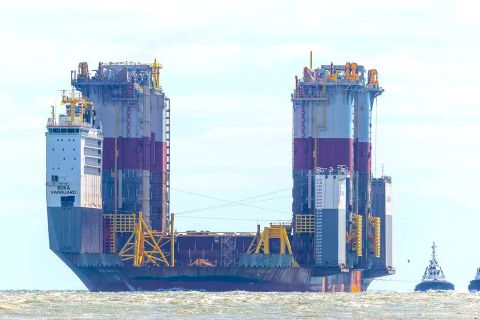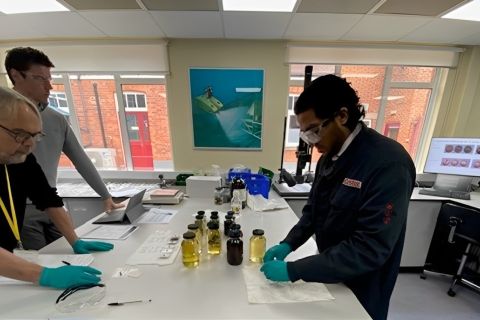The Canadian Association of Petroleum Producers' (CAPP) annual investment symposium this year was surprising only for its lack of surprises. Unlike the previous two years when multibillion-dollar takeovers animated discussions in the halls of a downtown Calgary hotel, the 2002 gathering was smaller and quieter, sometimes seeming to have all the fizz of a Pepsi open for two days. "Many of the characters, some of the more flamboyant ones, are no longer in the industry," says Bill Wheeler, president of Vancouver-based Leith Wheeler Investment Council Ltd. "I think the most obvious note this year is the middle zone has disappeared. For an investor looking at Canadian energy stocks, you either go with the really big guys or the really small guys. There's not much in between." Regardless of size, Canadian firms did their best impression of the cast of Stomp by constantly banging the drum of expanding oil and gas output. With high-tech and telecom stocks imitating butter left in the summer sun, it's important to demonstrate projects on the books that will add reserves and production, executives say. "I think one of the things that differentiates us is that there is visible growth," says Charlie Fischer, chief executive of Nexen Inc. "We don't have to do an acquisition to grow. If you look at other companies and look at their declines, you're not sure where that growth is going to come from. "The guys who have been growing with acquisitions have been paying pretty big prices for the barrels. We think that-full cycle-we can add barrels cheaper using our organic (exploration) strategy than you can by buying them." Nexen was among the larger firms highlighting international assets and big-buck, longer-term oil sands projects. Other players, including Petro-Canada, Suncor Energy Inc., Shell Canada Ltd., Imperial Oil Ltd. and Canadian Natural Resources Ltd., spent big chunks of their presentations outlining plans for heavy oil, oil sands and synthetic crude. (For more on oil-sands projects, see "Alberta's Heavy Oils," Oil and Gas Investor, October 2001.) The expensive lessons taught by hefty cost overruns suffered by Suncor and Shell are clearly being heeded. Perhaps nowhere is this more evident than in Canadian Natural's plan for its C$7.8-billion oil-sands development, "Horizon." The project is being broken into smaller phases to ensure better cost control. The first stage-110,000 barrels per day of bitumen-will come on by 2007, with the final target of 232,000 scheduled to be reached by 2011. Cost creep Canadian Natural's engineering will be 85% complete before construction begins, says Steve Laut, executive vice president of operations. Shell and Suncor's budgets were partially derailed because they went with a fast-track method, meaning changes in design translated into costly field reworking. "The disadvantage is that it takes you longer to get your production on. The advantage is that you have better cost control and it's easier to manage," Laut says. "I think the labor pool has changed in Fort McMurray [in Alberta] and all of the other players, including ourselves, are working more broadly together so we do not all build at the same time and create a huge demand for labor." The incremental approach is being used by Suncor for its next expansion, a project called Firebag expected to begin operation in 2005. The in-situ heavy oil development will add 140,000 barrels per day of output, which will be broken into four phases of 35,000. But even the smaller-is-better approach is not preventing cost creep, with Suncor ramping up Firebag's price tag to C$1 billion from its original estimate of C$750 million. The emphasis on oil sands by big companies in Canada is partially a response to the imperative to show investors growth or fall by the wayside. Canadian Natural, for example, is targeting annual growth of 10%. "There are very, very few projects in the world where you can bring on 232,000 barrels a day of light, sweet 34-degree-API crude for 50 years with no decline and gives you a return on capital anywhere between 14% and 22%, after-tax," Laut boasts. "These projects just don't exist that often." An oil-sands development provides producers with a welcome break from the tiring treadmill of replacing conventional oil wells that have annual production declines running around 25%, Nexen's Fischer says. In addition, the projects can generate substantial cash flow (assuming decent oil prices and consistent operating costs) that can be used to go after other opportunities, such as the Gulf of Mexico's deep waters or offshore western Africa. Glenn MacNeill, Toronto-based vice president of investment for Sentry Select Capital Corp., who manages a number of energy funds, says the massive scale of the Canadian energy industry's thrust was vividly illustrated through a tour of Shell Canada's Athabasca oil-sands project. Workers and equipment toiled busily on a Sunday to finish the C$5.2-billion project, which is expected to produce 155,000 barrels per day of bitumen later this year or in early 2003. "The continuing development of the oil sands certainly struck me as being one of the driving themes of the conference," he says. "I think they (projects by firms such as Shell, Nexen and Canadian Natural) represent Canada's future in the oil business." Trophy managers But oil sands are almost exclusively the purview of big companies. Smaller juniors and income trusts, which accounted for almost two-thirds of the CAPP conference's presenters, are generally sticking to conventional oil and gas plays in western Canada, although a few are operating overseas. Some of the most packed sessions were for companies led by seasoned veterans, sometimes called "trophy managers," cut loose by the severe consolidation that has led to many well-known names disappearing from the Canuck oil patch in the past two years. It was standing-room only, for example, when chief executive Don Archibald outlined plans for Cequel Energy Inc. The company is the sequel energy venture for managers from Cypress Energy, taken over last year for about C$190 million by PrimeWest Income Trust. These proven teams have been among the few able to raise equity this year, largely on the basis of past records. Cequel collected C$100 million between February and June from several heavily oversubscribed financings. "There is no doubt the market seems to like cases where you have experienced management in a new situation, and being on the inside, I can understand why," Archibald says. "I can see that I'm better at what I do, and our whole group just functions so much more efficiently than we used to. I bet we can get things done in 60% of the time it took us before." The big premiums carried by "hero managements" are not very attractive, says Wheeler, the Vancouver-based fund manager. In addition, the explosion in number of small companies is challenging for professional money-handlers because it is hard to take a sizable position that has a meaningful effect on portfolio's performance. Sentry's MacNeill likes veteran management but agrees it's tough for institutional investors to afford the large multiples these market darlings enjoy. For example, shares of Progress Energy Ltd. nearly doubled on news last November that it was getting new management led by Dave Johnson and other former senior executives of Encal Energy, which was taken over last year for C$1.8 billion by Calpine Corp. Progress recently completed a C$35.5-million acquisition (including debt of C$15.5 million) of Campion Resources Ltd., another junior. "I half-jokingly said to Dave: 'I understand you've made an acquisition and you're drilling some wells so finally you have some assets besides just your good name in your company,'" MacNeill says with a laugh. "There is lots of serendipity in this business. Some of the trophy managements are going to be able to make it; some are not." The emphasis on big names is putting pressure on other juniors competing for attention, money and properties. Grant Fagerheim, chief executive of Ketch Energy Ltd., deals with these problems every day. His well-regarded start-up is producing around 12,000 barrels of oil equivalent (BOE) per day, almost 60% to gas. The company is counting on production increases of close to 30% to impress analysts and investors. However, Ketch is not pursuing growth at all costs, he adds. "When you're doing corporate acquisitions, earnings are more difficult to generate in the near term. You're looking to be earnings-positive and growing but more weighted, in our opinion, to cash flow and cash-flow-per-share growth. It comes back to return on capital employed, which is ultimately the primary driver." Complicating life for all juniors is a quiet divestiture market. Many believed the buyers of the past two years, handicapped by high debt and weak commodity prices early in 2002, would flood the market with property packages. The rebound in commodity prices is reducing the need to sell, resulting in the anticipated buyer's market evaporating like a desert mirage. "Companies that could potentially dispose of assets are holding onto them because the return just in cash flow from those assets is much higher than expected," Fagerheim says. Lower service costs, down by about 15% from last year, are also making it more attractive to find production instead of buying it, he adds. The moribund oil-and-gas property market shows companies need to have an inventory of drilling prospects, perhaps holding enough work for two or three years in core areas, to ensure growth projections are based on a solid foundation, MacNeill says. "The ones that get very lucky and hit something-they're expensive to buy. If you can see good solid growth during the next two years, then that's a company you should be owning." Some of the recycled managers intend to grow production for several years before selling the firm, perhaps to a royalty trust, and then starting over again. But Archibald says the future of Cequel will depend more on market conditions than achieving any volume targets or reaching a self-imposed deadline. "I think it's wrong to have a strategy in place that says this is what you're going to do at a certain point in time because you can never predict where the buyers are," he explains. "All we know is that the life-cycle of small oil and gas companies is around five years. There may be an acquirer or maybe you look at alternative structures [like a trust] but something will happen to it. In the meantime, you just keep trying to grow a good company with good assets." Royalty trusts Some of the chatter at the conference, which had about 275 registered participants (down 10% from 2001), focused on Storm Energy Inc.'s decision to roll about 75% of its assets into a royalty trust. Its announcement followed one made in May by Paramount Resources Ltd., which said it would spin some of its northern Alberta gas properties into a trust as part of its acquisition of Summit Resources Ltd. Storm was respected and had a track record of success, but income trusts' higher trading multiples (based on cash flow) mean other E&P firms may follow Storm's and Paramount's examples, says Brian Prokop, analyst with Calgary-based brokerage Peters & Co. "Companies are saying: 'We'll take some of our mature assets that have good development opportunities during the next two to three years, put them into a royalty trust and realize a high value for those assets, higher than if they stayed under the auspices of an existing oil and gas company." With investors looking for growth, it's a lot easier to double in size to 8,000 BOE per day from 4,000 than it is to go to 20,000 from 10,000, Prokop notes. Both Ketch's Fagerheim and Cequel's Archibald say they intend to watch closely the fate of Storm and Paramount. "We get the benefit of learning from other people's experiences," Archibald says. "From my standpoint that's wonderful because they've now set a precedent. I get to watch [Paramount and Storm] to see whether or not that structure works." MacNeill says it's almost impossible to pick companies today on hopes they might turn part of their production into an energy trust down the road. However, he expects the trend will continue but not impair the overall health of the exploration side of the business. "We buy these companies with the idea that management is going to do everything it can to maximize value and if this means turning themselves into a royalty trust, so be it. "Storm did a great job of growing through both acquisition and the drillbit and now has maximized the value of the company by separating it into a trust and an exploration company." Storm is setting up its trust so management receives no bonus for completing acquisitions and divestitures, a move that will pressure existing players with such payments. Some of the fees are a holdover from early days when entrepreneurs risked their own capital to set up a royalty trust, says Don Garner, president of PrimeWest. There is no risk for conversions like the one envisioned by Storm so it makes sense to drop the charges, which have long been an irritant for institutional buyers. PrimeWest, which expects to produce about 30,000 BOE per day this year, is changing its management structure, including fees, to remain competitive with other participants in the niche. "Investors are just looking at their choices today and they don't necessarily care about what happened five years ago; they're looking at today's choices and what's the most efficient way to go," he says. "My clear drive and strategy is that a year from now PrimeWest will be one of the most, if not the most, cost-competitive trusts out there." Like other Canadian income trusts such as Enerplus Resources Fund and Pengrowth Energy Trust, PrimeWest intends to list on the New York Stock Exchange. Garner says PrimeWest is looking to tap the wider U.S. capital market, especially as the Canadian income scene becomes more crowded as anyone, from a sardine-packer to an ice-maker, stampedes into the sector. The plethora of trusts has Garner expecting consolidation within the sector during the next five years. Peters' Prokop says income trusts in Canada are approaching the saturation point. He says trusts are better managing cash flow to endure occasional rough rides on the commodity-price carousel. The real test of their staying power will be withstanding larger fluctuations in the interest-rate cycle, something that hasn't been experienced in almost two decades. Looking ahead to the remainder of the year, Prokop says the meltdown in tech stocks will likely turn more investors to natural-resources plays, where the companies have assets that can be seen and touched. There has also been no major financial or reserve explosion among Canadian energy producers for several years.
Recommended Reading
SLB OneSubsea JV to Kickstart North Sea Development
2024-05-07 - SLB OneSubsea, a joint venture including SLB and Subsea7, have been awarded a contract by OKEA that will develop the Bestla Project offshore Norway.
Chevron, Total’s Anchor Up and (Almost) Running
2024-05-07 - During the Offshore Technology Conference 2024, project managers for Chevron’s Anchor Deepwater Project discussed the progress the project has made on its journey to reach first oil by mid-2024.
Electric Hype vs. Hydraulic Reality: Advantages of Traditional Systems
2024-05-07 - Castrol's new fluid prevents gas hydrates in deepwater control systems.
EOG: Utica Oil Can ‘Compete with the Best Plays in America’
2024-05-06 - Oil per lateral foot in the Utica is as good as top Permian wells, EOG Resources told analysts May 3 as the company is taking the play to three-mile laterals and longer.
E&P Highlights: May 6, 2024
2024-05-06 - Here’s a roundup of the latest E&P headlines, including technology milestones and new contract awards.





